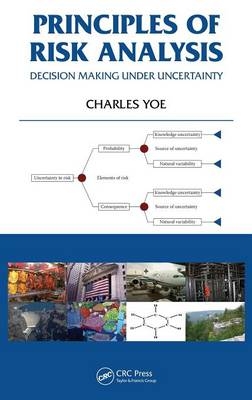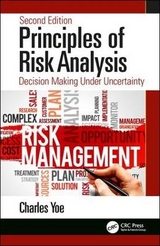
Principles of Risk Analysis
Crc Press Inc (Verlag)
978-1-4398-5749-6 (ISBN)
- Titel erscheint in neuer Auflage
- Artikel merken
Distilling the common principles of the many risk tribes and dialects into serviceable definitions and narratives, the book provides a foundation for the practice of risk analysis and decision making under uncertainty for professionals from all walks of life. In the first part of the book, readers learn the language, models, and concepts of risk analysis and its three component tasks—risk management, assessment, and communication. The second part of the book supplies the tools, techniques, and methodologies to help readers apply the principles. From problem identification and brainstorming to model building and choosing a probability distribution, the author walks readers through the how-to of risk assessment. Addressing the critical task of risk communication, he explains how to present the results of assessments and how to develop effective messages.
The book’s simple and straightforward style—based on the author’s decades of experience as a risk analyst, trainer, and educator—strips away the mysterious aura that often accompanies risk analysis. It describes the principles in a manner that empowers readers to begin the practice of risk analysis, to better understand and use the models and practice of their individual fields, and to gain access to the rich and sophisticated professional literature on risk analysis.
Additional exercises as well as a free student version of the Palisade Corporation DecisionTools® Suite software and files used in the preparation of this book are available for download.
Charles Yoe is a professor of economics at Notre Dame of Maryland University, Baltimore, U.S.A., and an independent risk analysis consultant and trainer. Working extensively for U.S. and other government agencies as a consultant and risk analyst, his wide range of risk experience includes international trade, food safety, natural disasters, public works, homeland security, ecosystem restoration, resource development, navigation, planning, and water resources. As a consultant to private industry, his work includes a discrete but wide variety of concerns. He has trained professionals from more than one hundred countries in risk analysis and conducted customized risk training programs for government agencies and private industry in over two dozen nations.
The Basics
What is Risk?
What Is Risk Analysis?
Why Do Risk Analysis?
Who Does Risk Analysis?
When Should We Do Risk Analysis?
Organization of Book
Uncertainty
Uncertainty from 75,000 Feet
The Uncertainty on Your Desk
Being Intentional About Uncertainty
Risk Management
Identifying Problems and Opportunities
Risk Estimation
Risk Evaluation
Risk Control
Risk Monitoring
Risk Management Models
Risk Assessment
What Makes a Good Risk Assessment?
Definitions
Risk Assessment Activities
Risk Assessment Models
Risk Assessment Methods
Risk Communication
Definitions
Internal Risk Communication
External Risk Communication
Problem Identification for Risk Management
What’s a Problem? What’s an Opportunity?
Becoming Aware of Problems and Opportunities
Problem and Opportunity Identification Techniques
The P&O Statement
Brainstorming
What Can You Brainstorm?
Background
Avoid Problems in Your Process
A Few Good Techniques
3× Yeah
Group Evaluations with Colored Dots
Do You Need a Facilitator?
Addendum
Opportunity Costs and Trade-Offs
Economics for Risk Managers
Economics and Decision Making
Economic Basis for Interactions among People
Principles of the Economy as a Whole
Making Trade-Offs
Economic Analysis
Qualitative Risk Assessment
Risk = Probability × Consequence
A Generic Process
More or Less Risk
Risk Narratives
Evidence Maps
Ordering Techniques
The Risk Matrix
Qualitative Risk Assessment Models
MCDA
A Semiquantitative Risk Assessment Example
The Art and Practice of Risk Assessment Modeling
Types of Models
A Model-Building Process
Simulation Models
Required Skill Sets
Probability Review
Two Schools of Thought
Probability Essentials
How Do We Get Probabilities?
Working with Probabilities
Why You Need to Know This
Choosing a Probability Distribution
Graphical Review
Strategy for Selecting a Probability Distribution
Example 1
Example 2
A Dozen Useful Probability Distributions for Risk Assessors
Probability Elicitation
Probability Words
Subjective Probability
When to Do an Elicitation
Making Judgments under Uncertainty
Responding to Heuristics
The Elicitation Protocol
Calibration
Multiple Experts
Monte Carlo Process
Background
A Two-Step Process
How Many Iterations?
Sampling Method
An Illustration
Probabilistic Scenario Analysis
Common Scenarios
Types of Scenario Analysis
Scenario Comparisons
Tools for Constructing Scenarios
Adding Probability to the Scenarios
An Example
Sensitivity Analysis
Qualitative Sensitivity Analysis
Quantitative Sensitivity Analysis
The Point
Presenting and Using Assessment Results
Understand Your Assessment Output Data Before You Explain It
Examine the Quantities
Examine the Probabilities
Examine Relationships
Answer the Questions
Visualization of Data
Decision Making under Uncertainty
Message Development
Communication Models
The Need for Message Strategies for Risk Communication
Crisis Communication
Message Mapping
Impediments to Risk Communication
Developing Risk Communication Messages
Appendix A: The Language of Risk and ISO 31000
ISO 31000
Enterprise Risk Management
Observations
Appendix B: Using Palisade’s Decision Tools Suite
TopRank
@RISK
PrecisionTree
Index
All chapters include an introduction, summary, and references.
| Zusatzinfo | approx 16 equations; 73 Tables, black and white; 222 Illustrations, black and white |
|---|---|
| Verlagsort | Bosa Roca |
| Sprache | englisch |
| Maße | 156 x 234 mm |
| Gewicht | 930 g |
| Themenwelt | Technik ► Maschinenbau |
| Wirtschaft ► Betriebswirtschaft / Management ► Allgemeines / Lexika | |
| ISBN-10 | 1-4398-5749-0 / 1439857490 |
| ISBN-13 | 978-1-4398-5749-6 / 9781439857496 |
| Zustand | Neuware |
| Informationen gemäß Produktsicherheitsverordnung (GPSR) | |
| Haben Sie eine Frage zum Produkt? |
aus dem Bereich



